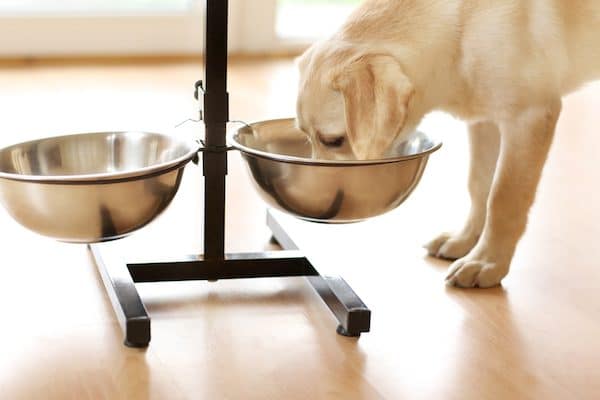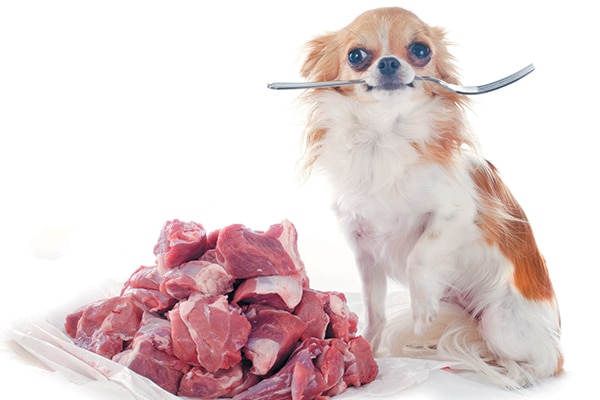“Mucus.” This was my least favorite word when I began formulating fresh food dog diets several years ago. Whenever I spotted a client email with the word “mucus” in the subject line, I’d cringe. While many factors can cause a dog to have mucus in the stool, a pattern quickly emerged, with a common culprit leaping out at me: fat. I never formulated “fatty” diets, but I learned quickly that many dogs have a problem digesting even moderate amounts of fat.
Invariably, lowering the fat level led to happier email reports of “well-formed stools.”
The most obvious and impactful way to cut the fat in your dog’s diet is to opt for lean meats. According to the United States Department of Agriculture, “lean” beef contains less than 10 percent fat and “extra-lean” beef contains less than 5 percent fat.
Let’s explore the benefits of lean meats in dog diets.

Lean meats are easier for dogs to digest
As I mentioned, many modern companion dogs don’t digest fatty meats well. This makes sense because dogs did not evolve eating lots of fat. In the wild, prey animals are naturally leaner and more muscular. They are not “fattened up” like today’s factory-farmed animals.
Lean meats are packed with protein
High-quality animal protein provides an abundance of essential amino acids dogs need to thrive. When the fat content in a given amount of meat increases, the protein level decreases.
Let’s compare the amount of protein and fat supplied by 1,000 calories’ worth of raw ground beef containing 30 percent fat, 20 percent fat and 10 percent fat: Note that the 10 percent fat ground beef supplies more than one and a half times as much protein as the 20 percent fat ground beef and more than two and a half times as much protein as the 30 percent fat ground beef! Diets dominated by fatty meats may lead to amino acid deficiencies, especially for growing puppies, who require more than double the protein as their adult counterparts.

Lean meats are easier on the waistline. Do you notice anything else revealing in our ground beef chart? To get the same amount of calories, a dog consuming 10 percent fat ground beef can eat virtually double the amount of meat (by weight) as a dog eating 30 percent fat ground beef.
Fat contains more than twice the calories per gram as protein and carbohydrates. So, the more fat dense a food, the more calorically dense — and this means Buddy gets to chow down on a lot less food. Bonus: Lean meats help overweight dogs shed pounds while still feeling satiated.
Lean meats won’t trigger pancreatitis. Fatty foods can trigger pancreatitis or inflammation of the pancreas. The pancreas produces the hormone insulin, which controls blood sugar levels, and it secretes enzymes to digest protein, fat and carbohydrates. When the pancreas functions properly, the digestive enzymes it produces remain inactive until they reach the small intestine. However, during pancreatitis, these enzymes activate much faster and leak into the pancreas, causing it to digest itself. Cut down on fat to decrease your dog’s chances of suffering from this painful and potentially life-threatening condition.
Calculating lean meats for dogs by weight
Lean meat commercial raw diets are more likely to be balanced, but do your research. To meet profit margins, some raw food companies opt for less-expensive, fattier cuts of meat over expensive leaner cuts. In addition, most raw pet food companies report nutrient values based on the food’s weight (nutrient levels per kg dry matter [DM]) rather than calories (nutrient levels per 1,000 kcal). Formulating high-fat raw diets based on weight (DM) without adjusting the nutrient levels to account for the food’s higher energy density results in inaccurate reporting.
Let’s refer back to our ground beef chart. Again, a dog eating 30 percent fat ground beef will consume almost half the amount as a dog eating 10 percent fat ground beef. The “30 percent dog” will also get about half as much of every other nutrient, unless these nutrients, including vitamins, minerals and essential fatty acids, have been proportionally increased to compensate for the decreased amount being consumed. As a result, commercial raw foods that appear to meet AAFCO standards for “complete and balanced” when calculated by weight may in fact be deficient in one or more nutrients when calculated by calories (kcal).
Lean meats to incorporate into healthy dog diets
- Ground meat (beef, bison, chicken, turkey) labeled 90 percent lean or leaner
- Cuts of beef or pork with “loin” or “round” in the name (top sirloin, top loin, top round, bottom round steak, pork tenderloin)
- Shank half of leg of lamb (lean part only)
- Lamb, cubed for stew or kabob, from leg or shoulder (lean part only)
- Chicken breast (skinless)
- Chicken, white meat (skinless)
- Chicken, thigh meat (skinless)
- Chicken, dark meat (skinless)
- Turkey breast (skinless)
- Turkey, light meat (skinless)
- Turkey, dark meat (skinless)
- Turkey thigh (skinless)
- Goat
- Rabbit
- Quail (skinless)
Read more about dog food and dog diets on Dogster.com:
- The Top Dog Food for Keeping Your Dog Cool in the Summer
- Dog Digestion: How Long Does it Take for a Dog to Digest Food and Other Basics
- Olive Oil for Dogs — 8 Reasons to Add it to Your Dog’s Diet
Diana Laverdure- Dunetz, MS, is a canine nutritionist and co-author, with W. Jean Dodds, D.V.M., of two books, including Canine Nutrigenomics: The New Science of Feeding Your Dog for Optimum Health. Their online course, Complete Canine Nutrition, can be found at myhealthy dog.dog.
Featured Image Credit: CynoClub/Thinkstock.





